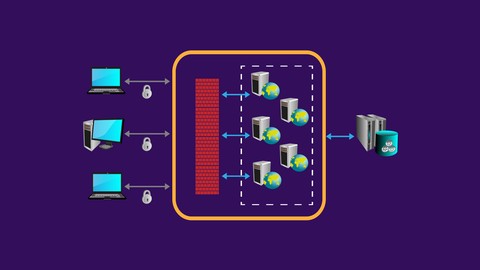
The Complete Microservices With Java
The Complete Microservices With Java, available at $49.99, has an average rating of 2.85, with 55 lectures, based on 86 reviews, and has 1479 subscribers.
You will learn about Familiarize yourself with the microservices architecture and its benefits Use dropwizard to develop microservices Create a database backed RESTlike API using Dropwizard Learn how to use database migrations with dropwizard application Learn how to create gradle tasks to automate out developing process Learn docker, docker-compose. Deploy our microservice to docker environment. Learn kubernetes Deploy our microservice to kubernetes locally. Create and configure google kubernetes engine clusters Create cloudSql instance, credentials and link them with out microservice Deploy microservice to google kubernetes engine Create docker images and push them to google container registry This course is ideal for individuals who are Intended for Java software developers or Software Developers or Web Developers or Programmers or NOT intended for beginners. However, depending on your technical experience in other technologies, and your learning style, you may find this course a fascinating deep-dive into Microservices, dropwizard, docker, kubernetes applications. It is particularly useful for Intended for Java software developers or Software Developers or Web Developers or Programmers or NOT intended for beginners. However, depending on your technical experience in other technologies, and your learning style, you may find this course a fascinating deep-dive into Microservices, dropwizard, docker, kubernetes applications.
Enroll now: The Complete Microservices With Java
Summary
Title: The Complete Microservices With Java
Price: $49.99
Average Rating: 2.85
Number of Lectures: 55
Number of Published Lectures: 55
Number of Curriculum Items: 55
Number of Published Curriculum Objects: 55
Original Price: $139.99
Quality Status: approved
Status: Live
What You Will Learn
- Familiarize yourself with the microservices architecture and its benefits
- Use dropwizard to develop microservices
- Create a database backed RESTlike API using Dropwizard
- Learn how to use database migrations with dropwizard application
- Learn how to create gradle tasks to automate out developing process
- Learn docker, docker-compose.
- Deploy our microservice to docker environment.
- Learn kubernetes
- Deploy our microservice to kubernetes locally.
- Create and configure google kubernetes engine clusters
- Create cloudSql instance, credentials and link them with out microservice
- Deploy microservice to google kubernetes engine
- Create docker images and push them to google container registry
Who Should Attend
- Intended for Java software developers
- Software Developers
- Web Developers
- Programmers
- NOT intended for beginners. However, depending on your technical experience in other technologies, and your learning style, you may find this course a fascinating deep-dive into Microservices, dropwizard, docker, kubernetes applications.
Target Audiences
- Intended for Java software developers
- Software Developers
- Web Developers
- Programmers
- NOT intended for beginners. However, depending on your technical experience in other technologies, and your learning style, you may find this course a fascinating deep-dive into Microservices, dropwizard, docker, kubernetes applications.
In this course you’ll learn how to create a simple microservice using Java programming language and Dropwizard.
Dropwizard is a popular framework to build RESTful APIs and microservices. The course begins with a brief introduction to microservices VS monolith architectural styles and microservices design principles.
In this course, you will build a locations microservice which will host a predefined list of locations like Amazon FBA locations, this will be done by creating a REST API’s for CRUD operations (create, read, update, delete), and you will learn how to connect our microservice with mysql database locally, and also how to configure phpmyadmin in order to interact with locations database.
(FULL REPOSITORY CODE EXIST THROUGH SECTIONS!)
After that you will learn how to decorize you microservice with docker and create a docker image of locations microservices, and you will learn how deploy the microservice to docker environment and how to create applications containers and connect them with each other.
Also, you will learn about kubernetes (k8s), and how to configure k8s on your local machine, and create deployment descriptors (YAML) files, in order to deploy the microservice to local k8s cluster.
And finally, you’ll learn how to create a google cloud account and configure google kubernete engine, google cloud sql, cloud sql credentials, push docker images to google container registry, Then deploy your microservice there.
In this course we will depend on gradle build tool, in order to automate our development process and save our time!
The goal of this course is to serve as a practical guide through the dropwizard framework, so you can see how it’s used to implement microservice based architecture.
By the time you finish this course, you will have gained the ability to articulate what the Microservices architectural style is all about, including its advantages and disadvantages, docker and kubernetes.
You will gain familiarity with dropwizard, and you’ll see how to use it to build microservices, REST API’s.
Is This For You?
- Do you want to build useful microservices?
- Are you afraid of not being able to create good microservices?
- Do you think you will feel proud creating the microservices that will be used every day and help others to work more effectively?
Then this course will definitely help you.
The course currently consists of 54 lectures and 7 hours of video. After taking this course you’ll be able to start developing microservices. So let’s get started!
Course Curriculum
Chapter 1: Introduction
Lecture 1: Course Introduction
Chapter 2: Microservices VS Monolithic Styles
Lecture 1: Before microservices (Monolithic architectural style)
Lecture 2: What is microservice?
Lecture 3: Microservices design principles
Chapter 3: Installation
Lecture 1: Install Java 8
Lecture 2: Install Intellij Idea 2017
Lecture 3: Install Xampp
Lecture 4: Install Gradle build tool
Chapter 4: Getting started with dropwizard
Lecture 1: Creating the application by intellij Idea
Lecture 2: Technical design for locations microservice
Lecture 3: Implement the basic model and static data
Lecture 4: Creating Rest locations resource
Lecture 5: Create Database schema
Lecture 6: Connecting the DB with our application
Lecture 7: Data Access Layer with Mapper
Lecture 8: Creating the locations service and implement the business logic
Lecture 9: Implement getLocation method
Lecture 10: Implement inserting new locations
Lecture 11: Implement editing locations
Lecture 12: Implement delete locations
Chapter 5: Getting started with docker
Lecture 1: Life before docker?!
Lecture 2: What is docker?
Lecture 3: Install Docker and Docker-Compose
Lecture 4: Creating Dockerfile
Lecture 5: Prepare files for docker environment
Lecture 6: Some refactoring before creating the docker image
Lecture 7: Create docker image
Lecture 8: Create and run docker container
Lecture 9: Docker compose create mysql descriptor
Lecture 10: Docker compose phpmyadmin
Lecture 11: Docker compose locations
Lecture 12: Docker compose run containers
Chapter 6: Getting started with kubernetes
Lecture 1: Install kubernetes (k8s) components locally (VBox, kubectl, Minikube)
Lecture 2: What is kubernetes?
Lecture 3: Mysql deployment descriptor
Lecture 4: Mysql service descriptor
Lecture 5: Local volume descriptor
Lecture 6: Phpmyadmin deployment descriptor
Lecture 7: Phpmyadmin service descriptor
Lecture 8: Locations-service deployment descriptor
Lecture 9: Locations-service service descriptor
Lecture 10: Deploy to kubernetes locally 1
Lecture 11: Deploy to kubernetes locally 2
Lecture 12: Deploy to kubernetes locally 3
Chapter 7: Deploy to google kubernetes engine
Lecture 1: Overview and signup!
Lecture 2: Install gcloud SDK
Lecture 3: Point kubectl to cloud cluster
Lecture 4: Create gradle tasks to push (our app) image to google container registry.
Lecture 5: Build and push docker images
Lecture 6: Create gradle tasks to deploy against GKE
Lecture 7: Create cloud sql instance and configure the credentials
Lecture 8: Create descriptors for production environment 1
Lecture 9: Create descriptors for production environment 2
Lecture 10: Deploy to production!
Chapter 8: Testing
Lecture 1: Introduction
Instructors
-
Mo omar
Full Stack + DevOps software Engineer
Rating Distribution
- 1 stars: 17 votes
- 2 stars: 12 votes
- 3 stars: 17 votes
- 4 stars: 21 votes
- 5 stars: 19 votes
Frequently Asked Questions
How long do I have access to the course materials?
You can view and review the lecture materials indefinitely, like an on-demand channel.
Can I take my courses with me wherever I go?
Definitely! If you have an internet connection, courses on Udemy are available on any device at any time. If you don’t have an internet connection, some instructors also let their students download course lectures. That’s up to the instructor though, so make sure you get on their good side!
You may also like
- Best Cybersecurity Fundamentals Courses to Learn in December 2024
- Best Smart Home Technology Courses to Learn in December 2024
- Best Holistic Health Courses to Learn in December 2024
- Best Interior Design Courses to Learn in December 2024
- Best Nutrition And Diet Planning Courses to Learn in December 2024
- Best Yoga Instruction Courses to Learn in December 2024
- Best Stress Management Courses to Learn in December 2024
- Best Mindfulness Meditation Courses to Learn in December 2024
- Best Life Coaching Courses to Learn in December 2024
- Best Career Development Courses to Learn in December 2024
- Best Relationship Building Courses to Learn in December 2024
- Best Parenting Skills Courses to Learn in December 2024
- Best Home Improvement Courses to Learn in December 2024
- Best Gardening Courses to Learn in December 2024
- Best Sewing And Knitting Courses to Learn in December 2024
- Best Writing Courses Courses to Learn in December 2024
- Best Storytelling Courses to Learn in December 2024
- Best Creativity Workshops Courses to Learn in December 2024
- Best Resilience Training Courses to Learn in December 2024
- Best Emotional Intelligence Courses to Learn in December 2024





















